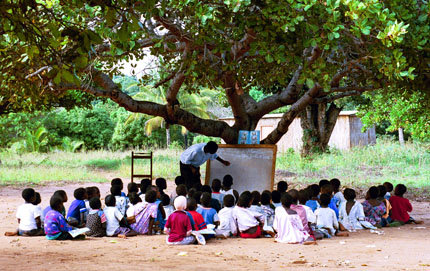About 57 million children of primary school age around the world do not attend school.
More than half of these children live in developing countries in sub-Saharan Africa, and more than 20% in South and West Asia. Fifty-four per cent of the children who do not attend school are girls.
For socially disadvantaged groups access to education is especially difficult. Apart from girls and women and poor people, these groups include indigenous peoples, religious, ethnic and linguistic minorities and people with disabilities. People living in conflict regions are also at a severe disadvantage.
- Education goals are not achieved.
In 2000, at the World Education Forum in Dakar, the international community adopted the Education for All Global Action Plan. 2015 was set as the target date for achieving the goals, the same date as for the Millennium Development Goals launched in the same year. Notwithstanding the substantial progress made in some countries, the global forecast in the EFA Global Monitoring Report 2013/14 is not rosy: “With the deadline for the Education for All goals less than two years away, it is clear that, despite advances over the past decade, not a single goal will be achieved globally by 2015.”
If the current trend continues, the goal of universal primary education will not be achieved. Although the number of children of primary school age not attending school went down between 1999 and 2011 from 108 million to 57 million – a huge step forward – the pace of progress has become extremely slow, indeed hardly any progress at all was made between 2008 and 2011. According to the EFA Global Monitoring Report, the shortfall in funding to achieve good quality basic education for all by 2015 has reached 26 billion US dollar annually.
- Cost of school fees
Many people in developing countries cannot afford the cost of school fees, books, other learning materials, school uniforms or transport to school. As a result, their children do not go to school or they drop out. In countries in which school fees have been removed, enrolment rates have risen markedly.
Numerous families rely on the income their children contribute. The International Labour Organization (ILO) estimates that some 215 million children between the ages of 5 and 17 years have to work, so there is often no time left to attend school.
- Lack of budget
Many countries cannot offer free education for financial resources are not available. In most developing countries, education budgets fall short of requirements. High national deficits are a further constraint. If the education system is to keep pace with the rapid growth in the number of school-age children in many – though not all – developing countries, investment will have to be substantially higher. Certainly the poorest developing countries will not be able to raise that money themselves. Bad governance, high staff turnover, corruption and a shortage of organizational and managerial skills are other obstacles to the universal provision of quality education.
- Poor quality teaching
The quality of teaching is poor in many developing countries. Even children who have completed primary school may lack basic skills in reading, writing and basic math. The curricula often lack clear targets, are overloaded with subjects, do not meet the learning needs of elementary school pupils, ignore cultural and regional factors, and put across distorted or stereotypical images of male and female social roles.
Other frequently encountered issues are a failure to bring teaching times and curricula into line with the everyday lives of children, and outdated teaching methods. Group work, independent learning, critical thought and problem solving, the use of new technologies and the development of life skills tend to be neglected. As a result, young people lack the essential knowledge and skills that will later give them the confidence to make their way in the labor market.
- Lack of schools and teaching staff
Not just rural regions, but many poor urban districts too lack a comprehensive network of primary schools. Children in rural regions may have to walk very long distances to school. Many girls are not allowed to attend schools if the school is too far because their parents are concerned about their safety.
Teachers’ working conditions in developing countries are frequently unacceptable: many teachers have to teach two or three shifts a day, with large classes and on poor pay. Many schools are poorly equipped and have no funding to cover overheads such as water, electricity or transport for the children.
Teachers may also be poorly trained and insufficiently prepared for their work. The low esteem in which the profession is held and the remote location of many schools do not make teaching an attractive profession.
- Lack of post-primary education
Increasing school enrolment rates and the rising numbers of children completing primary school education in the developing countries is giving rise to the need to create opportunities for post-primary education and vocational training. The opportunities available are still not adequate. In many cases they are not geared to the requirements of the economy, nor do they meet the needs of young people.
Vocational training systems are basic in many countries. The teaching is usually too theoretical and not in line with the needs of the labour market. Universities and colleges in developing countries are ill equipped materially and financially and few of them are able to carry out their teaching and research remit adequately.
